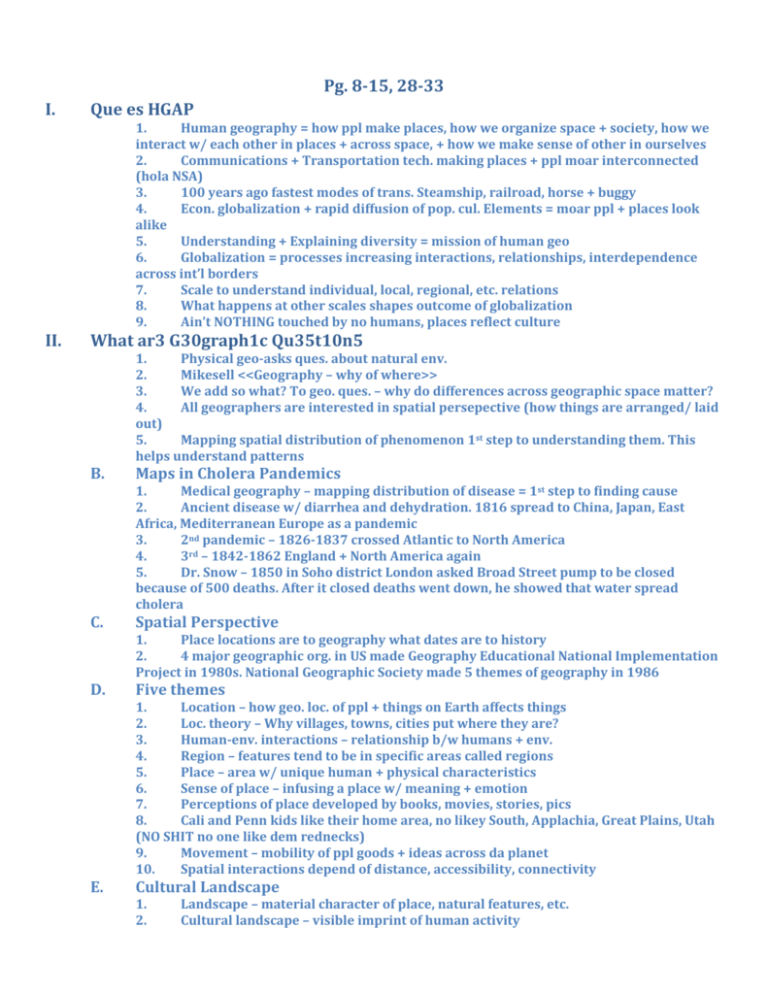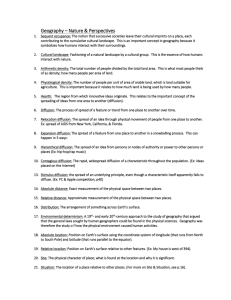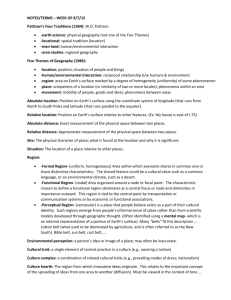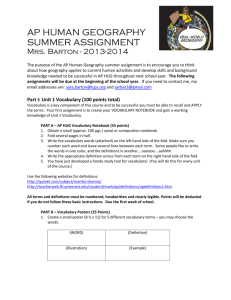Pg8-15 28-33 Notes
advertisement

Pg. 8-15, 28-33 I. II. Que es HGAP 1. Human geography = how ppl make places, how we organize space + society, how we interact w/ each other in places + across space, + how we make sense of other in ourselves 2. Communications + Transportation tech. making places + ppl moar interconnected (hola NSA) 3. 100 years ago fastest modes of trans. Steamship, railroad, horse + buggy 4. Econ. globalization + rapid diffusion of pop. cul. Elements = moar ppl + places look alike 5. Understanding + Explaining diversity = mission of human geo 6. Globalization = processes increasing interactions, relationships, interdependence across int’l borders 7. Scale to understand individual, local, regional, etc. relations 8. What happens at other scales shapes outcome of globalization 9. Ain’t NOTHING touched by no humans, places reflect culture What ar3 G30graph1c Qu35t10n5 B. 1. Physical geo-asks ques. about natural env. 2. Mikesell <<Geography – why of where>> 3. We add so what? To geo. ques. – why do differences across geographic space matter? 4. All geographers are interested in spatial persepective (how things are arranged/ laid out) 5. Mapping spatial distribution of phenomenon 1st step to understanding them. This helps understand patterns Maps in Cholera Pandemics 1. Medical geography – mapping distribution of disease = 1st step to finding cause 2. Ancient disease w/ diarrhea and dehydration. 1816 spread to China, Japan, East Africa, Mediterranean Europe as a pandemic 3. 2nd pandemic – 1826-1837 crossed Atlantic to North America 4. 3rd – 1842-1862 England + North America again 5. Dr. Snow – 1850 in Soho district London asked Broad Street pump to be closed because of 500 deaths. After it closed deaths went down, he showed that water spread cholera C. Spatial Perspective D. Five themes E. 1. Place locations are to geography what dates are to history 2. 4 major geographic org. in US made Geography Educational National Implementation Project in 1980s. National Geographic Society made 5 themes of geography in 1986 1. Location – how geo. loc. of ppl + things on Earth affects things 2. Loc. theory – Why villages, towns, cities put where they are? 3. Human-env. interactions – relationship b/w humans + env. 4. Region – features tend to be in specific areas called regions 5. Place – area w/ unique human + physical characteristics 6. Sense of place – infusing a place w/ meaning + emotion 7. Perceptions of place developed by books, movies, stories, pics 8. Cali and Penn kids like their home area, no likey South, Applachia, Great Plains, Utah (NO SHIT no one like dem rednecks) 9. Movement – mobility of ppl goods + ideas across da planet 10. Spatial interactions depend of distance, accessibility, connectivity Cultural Landscape 1. 2. Landscape – material character of place, natural features, etc. Cultural landscape – visible imprint of human activity III. Pg 28 3. Sauer <<cultural landscape – forms superimposed on physical landscape by human activity>> 4. Humans made imprint everywhere on earth 5. Sequent occupance – sequential imprint of occupants a) Tanzania good example (pg 15) 6. Lewis <<human landscape reflects us>> 7. Major changes in cultural landscape happen after major event (war, invention, economic depression) A. Culture B. Connectedness thru Diffusion (OHMYGOD #THISAINTBIO) C. D. 1. Culture refers to all ways of life, encompassing term id’ing whole tangible lifestyle of people + prevailing values + beliefs 2. Lies at heart of human geography 3. Hoebel <<culture – social invention transmitted + maintained solely thru communication + learning>> 4. Culture trait – single attribute of a culture a) Turbans often distinguish a man’s status in society/ worn as a sign of faithfulness to God. This is not limited to Muslims, in the US Sikhs wear them too. (Doesn’t mean they’re terrorists er mah gewd) 5. Culture complex – more than one culture may have a specific cultural trait, but each had discrete combination of traits 6. Cultural hearth – where cultural traits develop + diffuse from 7. Independent invention – trait developed in more than one hearth w/o being influenced by its development elsewhere 1. When ideas/ppl/goods move across space – cultural diffusion 2. Time-distance decay – farther away place is from hearth + longer it takes to reach a place, less of chance it will be accepted 3. Cultural barriers – Prescriptions cultures make about behavior, powerful obstacles for spread of ideas/inventions Expansion Diffusion (OH MY GOD WHERE IS THE KKK) 1. Islam’s hearth – Arabian Peninsula 2. Expansion Diffusion – innovation/idea stays strong in hearth + spreads outward 3. 2 types of diffusion: expansion + relocation (MR. KRAFT YOU WERE WRONG OOHHHH) 4. Croak, man from Toledo, Ohio made Silly Bandz in 2008 based off of a Japanese company’s product in China 5. Contagious diffusion – all adjacent individuals+places affected 6. Stores selling silly bandz make a hierarchy of diffusion 7. Phiten supporters think titanium restores balance, hacve shorts, athletic tapes, patches, and even bedding w/ aqua metals. (Yeah. Remember those idiots? They still exist.) 8. Diffusion of Phiten from Japan to US began with baseball, cuz they both share that sport in common, caught on hierarchically 9. Hierarchical diffusion – pattern where main channel of diffusion is some segment of those who will catch on to diffusion a) The other example is about crocs. I’m not gonna go over that because Crocs are stupid. It’s on page 31 if you want to read it. 10. Stimulus diffusion – changes that indirectly promote experimentation and changes in doing stuff a) India ppl can’t eat beef, so they made vegetable product burgers cuz of McDonalds. Diffusion of hamburger took on new form in India. Relocation Diffusion 1. Occurs most frequently thru migration IV. 2. Involves movement of individuals who have adopted a thing and carry it to a new place and disseminate it there What iz Geo. Concepts, How Are They Used in Answering Qs? 1. 2. Geographic concepts – boldfaces words in da book Today’s geography not environmental determinism B. Rejection of Environmental Deterism C. Possiblism D. 1. Aristotle <<European ppl – full of spirit, incapable of ruling others; Turkish (Asian back then) – intelligent + inventive, in state of subjection + slavery>> 2. Huntington + Cushing <<Climate affects how people behave>> 3. Env. determinism – human behavior affected/controlled by physical environment 4. People are decision makers and modifiers, not only affected by environment 1. Possibilism – choices society makes depends of what members need and what tech there is 2. Cultures push boundaries of what is env. possible by ideas and technology 3. Cultural ecology – culture as system of adaption + alteration of environment 4. Political ecology-env. consequences of political econ. arrangements+understandings 5. Human socities diverse, too powerful to be affected by environment Today’s Human Geo 1. 2. Human geo today looks to at spatial org. of human institutions on Earth Cultural geo. part of human geo. + own approach to human geo.









